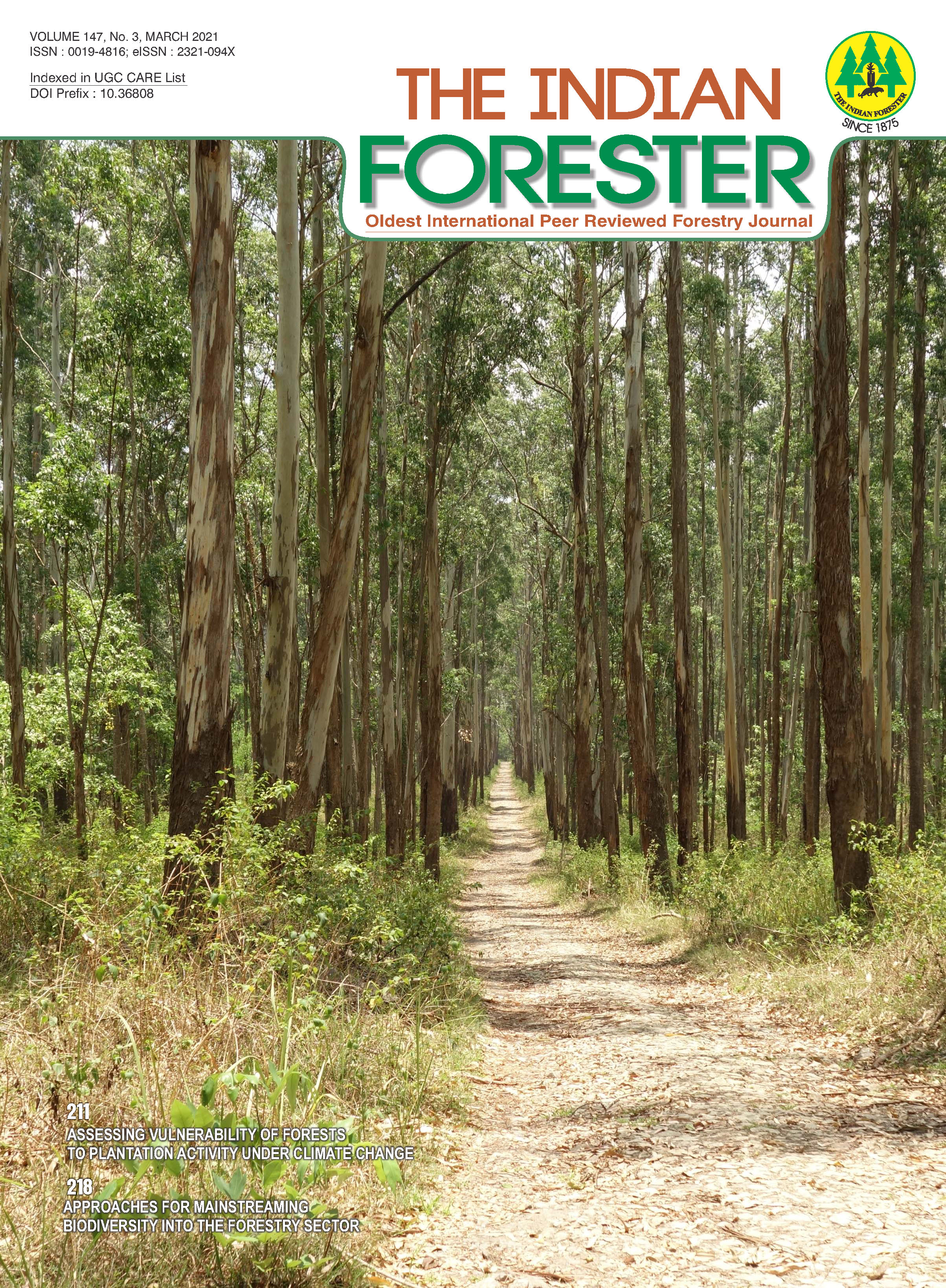Approaches for Mainstreaming Biodiversity into the Forestry Sector
DOI:
https://doi.org/10.36808/if/2021/v147i3/152215Keywords:
Access and Benefit-Sharing, Biodiversity, Ecologically Representative Areas, Mainstreaming, National Biodiversity Targets.Abstract
Forests are a dynamic natural resource. They offer a diverse set of habitats for plants, animals, and micro-organisms and hold the majority of the world's terrestrial species. However, these biologically rich systems are increasingly threatened, largely as a result of human activities. The Food and Agriculture Organization of the United Nations has estimated that since 1990 world has lost nearly 178 million ha. of forest. India is rich in biodiversity and it supports 49,003 species of plants and 1,00,693 species of animals and it ropes 16% of the human and 18% of the cattle population of the world. India's forest diversity includes 3794 trees, 3111 shrubs, and 2300 herbs. The forest cover of India constitutes 21.67 per cent of the geographic area of the country and nearly 1,70,000 villages are deriving benefits from the forests. The Convention on Biological Diversity has requested parties to address the loss of biodiversity through its global strategic plan for biodiversity and to mainstream biodiversity into all sectors. Some of the suggested approaches for mainstreaming biodiversity into the forestry sector include policy intervention; convergence of national and international instruments; multi-sectoral management and local institutional partnerships.References
Bhatt J.R., Singh J.S., Singh S.P., Tripathi R.S. and R.K. Kohli (Edited). Wallingford, UK: CABI (2012). Published by Cambridge University Press, ISBN 978-1-84593-907-6, Volume 48(4): 314 pp.
BSI (2018). Published in Floral Statistics of India, Plant discoveries, 2017-New Genera, Species and New Records edited by Paramjit Singh and S.S. Dash.
CBD (2015). Strategic issues related to the implementation of the Strategic Plan for Biodiversity 2011-2020. Conservation and sustainable use of biodiversity. UNEP/CBD/SBSTTA/19/INF/17, 1-23pp.
CBD (2019). Convention on Biological Diversity, Strategic Plan for Biodiversity 2011-2020, including Aichi Biodiversity Targets (online web source: www.cbd.int/sp).
FAO (2020). Global Forest Resources Assessment 2020 Key findings, Rome. https://doi.org/10.4060/ca8753en.
FSI (2015). State of Forest Report, Published by Forest Survey of India (FSI), MoEFCC, GoI, Dehradun. ISBN No: 97881929285-2-4, Volume 16: 1-288 pp.
FSI (2019). State of Forest Report, Published by FSI, MoEFCC, GoI. ISBN 978-811 941018-0-2, Edition 16, Volume 1: 1-167 pp.
ISFR (2011). India State of Forest Report (ISFR), Published by the Forest Survey of India, MoEFCC, Government of India, 1-286 pp.
MoEFCC and GIZ. (2014). The Economics of Ecosystems and Biodiversity (TEEB) India Initiative: Interim Report Working Document. 92p
MoEFCC (2014). India's Fifth National Report to the Convention on Biological Diversity, Government of India, 100 pp.
National Biodiversity Action Plan (NBAP) (Addendum 2014 to NBAP 2008). Published by the Ministry of Environment, Forests and Climate Change, Government of India, 1-75pp.
National Working Plan Code (NWPC) (2014). Published by the Forest Research Institute, Dehradun (Indian Council for Forestry Research and Education), MoEFCC, GoI, pp 1-86.
National Forest Policy (1988). No.3-1/86-FP, Published by the MoEFCC (Department of Environment, Forests and Wildlife) Paryavaran Bhavan, New Delhi - 110 003, 1-10 pp.
Parikh K.S., Rvindranath N.H., Murthy I.K., Mehra S., Kumar R., James E.J., Vivekanandan E. and Mukhopadhyay P. (2012). The Economics of Ecosystems and Biodiversity- India: Initial Assessment and Scoping Report. Working Document 157pp, Published by MoEFCC, Government of India.
Thomson Jacob C., Giridhar Kinhal and B. Meenakumari (2019). Mainstreaming Biodiversity Concerns into Forestry and Forest Management, Published by the Centre for Biodiversity Policy and Law, National Biodiversity Authority, ISBN No: 978-81-940589-0-8, pp 1-56.
UNDP (2018). Achievement of Aichi Biodiversity Targets 11 and 16 Success stories from India, Published by the United Nations Environmental Programme, 1-19 pp.
Wildlife (Protection Act), (1972), No.53 of 1972. Published by MoEFCC, GoI.
World Bank (2006). India: Unlocking Opportunities for forest dependent people in India. Report No. 34481-IN, World Bank: South Asia Region, pp.85.
WWF (2019). (online source: www.wwfindia.org).
ZSI (2017). Animal Discoveries 2016- New Specie and New Records Edited by Kailash Chandra and Sheela, 2018. Published by Zoological Survey of India (ZSI), MoEFCC, Government of India.
Downloads
Downloads
Additional Files
Published
How to Cite
Issue
Section
License
Unless otherwise stated, copyright or similar rights in all materials presented on the site, including graphical images, are owned by Indian Forester.





